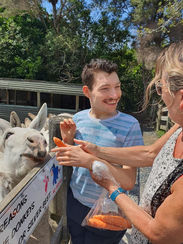
THERAPIES
Current treatments for Angelman syndrome, focus on managing the symptoms and developmental delays. Early intervention and ongoing therapies are crucial for maximizing development and quality of life. Though it is best to start as early as possible, many new skills can still be learnt well into adulthood.
A team of healthcare professionals, including doctors, therapists, and other specialists, is essential for providing comprehensive care. Research is ongoing to develop new and more effective therapies for Angelman syndrome.
For more clinical treatments and therapies, see Medical.
Pre-school Learning & Development Support
Early intervention
Early intervention support teams help tamariki (children) at home and in their early learning centres. They are available from birth through to starting school. Children with Angelman Syndrome benefit greatly from selected therapy services and they continue to learn and improve throughout their lives. The 3 primary therapy services listed below are beneficial to early childhood development, and to help set children up to achieve their full potential.
-
Speech & language therapy (with AAC)
-
Physiotherapy
-
Occupational therapy
In addition to the above, they can also benefit greatly from alternative therapies such as hippotherapy, hydro/aquatic therapy, music therapy, art therapy and pet therapy – depending on each individual’s preferences and inclinations.
Behavuoyral therapy
In addition to the 3 primary therapies, people with Angelman syndrome can also benefit greatly from alternative therapies such as hippotherapy, hydro/aquatic therapy, music therapy, art therapy and pet therapy – depending on each individual’s preferences and inclinations.












